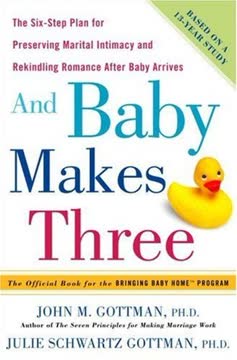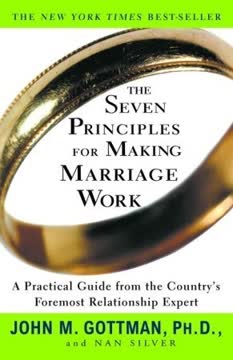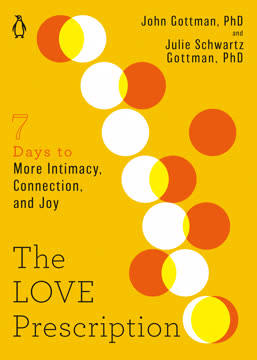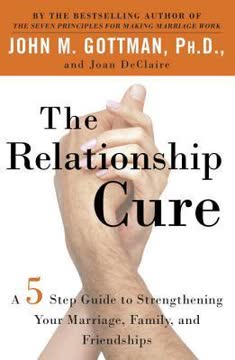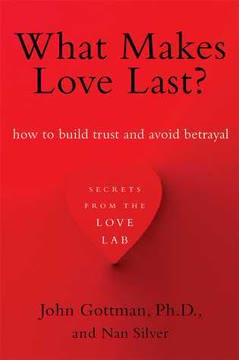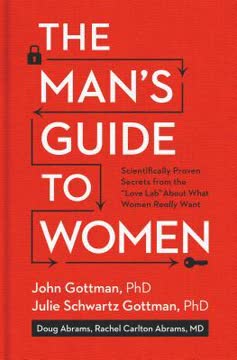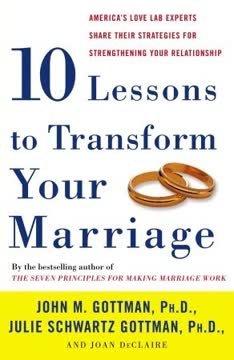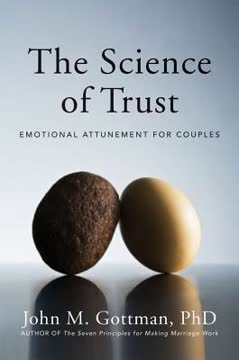Key Takeaways
1. Acknowledge Shared Challenges in Parenthood
The greatest gift you can give your baby is a happy and strong relationship between the two of you.
Universal struggles. Recognize that most couples experience a decline in relationship satisfaction after the birth of a baby. Increased conflict, decreased intimacy, and exhaustion are common challenges, not signs of a failing relationship. Understanding this shared experience can foster empathy and reduce blame.
Common stressors:
- Sleep deprivation and fatigue
- Increased household chores and childcare responsibilities
- Decreased time for intimacy and romance
- Feelings of being unappreciated and neglected
- Changes in identity and values
Shift perspective. Instead of viewing these challenges as personal failures, acknowledge them as normal aspects of the transition to parenthood. This shared understanding can pave the way for collaborative problem-solving and mutual support.
2. Embrace the Competence of Babies and Parents
Our babies want to interact with us from the moment they’re born. And our face is a Picasso to them.
Innate abilities. Recognize that newborns possess remarkable abilities, including mimicking facial expressions and distinguishing their parents' voices. Parents also have strong instincts to nurture and respond to their babies' needs. Trusting these innate abilities can foster confidence and joy in parenting.
Face-to-face play:
- Babies are fascinated by faces, especially those making exaggerated expressions.
- Parents instinctively engage in "baby talk," using higher pitches and enunciating clearly.
- Taking turns and responding to baby's cues are essential for healthy interaction.
Avoid "still face." Be mindful of the importance of responsiveness. Babies dislike a blank, unresponsive face and need parents to be fluid and engaged.
3. Transform Conflicts into Opportunities for Connection
The secret to managing conflicts for new parents is to make the fights constructive, not destructive.
Constructive vs. destructive. Focus on managing conflicts in a way that strengthens, rather than weakens, the relationship. Constructive conflict involves respect, gentleness, and taking responsibility, while destructive conflict is characterized by criticism, defensiveness, and disrespect.
Key elements of constructive conflict:
- Respectful communication
- Active listening
- Acknowledging each other's perspectives
- Willingness to compromise
Avoid the Four Horsemen. Be mindful of criticism, defensiveness, contempt, and stonewalling, which are strong predictors of relationship demise. Replace these behaviors with their antidotes: gentle complaints, taking responsibility, appreciation, and self-soothing.
4. Soft Start-Ups: The Key to Constructive Conversations
When we introduce an issue with harsh start-up, one of us blames the other, usually with criticism or contempt.
Gentle vs. harsh. The way a conversation begins significantly impacts its outcome. Harsh start-ups, characterized by blame and criticism, often lead to defensiveness and escalation. Softened start-ups, which express feelings and needs without blame, create a more receptive environment for discussion.
Three steps to a softened start-up:
- Express your feelings ("I feel...")
- Describe the situation neutrally ("about...")
- State what you need ("I need...")
Practice makes perfect. Consciously practice converting harsh start-ups into softened ones. This skill can significantly improve the quality of conflict discussions and foster greater understanding.
5. Accept Influence: Value Each Other's Perspectives
In any argument or miscommunication, there is not one objective, absolute reality. There are always two subjective realities, both of them right in their own way.
Two realities. Acknowledge that every conflict has two valid perspectives. Instead of trying to prove your partner wrong, focus on understanding their point of view. This requires active listening, empathy, and a willingness to accept influence.
Rapoport's Rules:
- Postpone persuasion until you can state your partner's point of view to their satisfaction.
- Ask open-ended questions to understand their perspective.
- Assume similarity: recognize that both partners have positive and negative qualities.
Validation is key. Acknowledge that your partner has a right to feel the way they do, even if you don't share their perspective. This can be as simple as saying, "I get it" or "Good point."
6. Self-Soothing: A Vital Skill for Managing Stress
If we get too overwhelmed, we need to take responsibility for our bodies’ condition by taking a break, soothing ourselves, and making sure we come back to our partners within a reasonable time period.
Diffuse Physiological Arousal (DPA). Understand that conflict can trigger a "fight or flight" response, leading to increased heart rate, tunnel vision, and impaired listening. Recognize the signs of DPA and take steps to calm down before continuing the discussion.
Take a break. When feeling overwhelmed, request a break of at least 30 minutes to self-soothe. During this time, engage in activities that promote relaxation, such as deep breathing, meditation, or listening to music.
Self-soothing techniques:
- Deep breathing exercises
- Progressive muscle relaxation
- Guided imagery
- Engaging in enjoyable activities
7. Compromise: Finding Win-Win Solutions
Nobody wins or loses in compromise. We gain a little of what we want, and surrender a little, too.
Mutual benefit. Approach conflict resolution with the goal of finding a compromise that meets both partners' needs. This requires flexibility, creativity, and a willingness to let go of rigid positions.
Two-circle method:
- Identify your core needs, which are non-negotiable.
- Identify areas where you are flexible and willing to compromise.
- Find a solution that honors both partners' core needs and allows for flexibility in other areas.
Open communication. Ask open-ended questions to understand your partner's needs and concerns. Validate their perspective and acknowledge their right to feel the way they do.
8. Repair Attempts: Mending the Rifts
A repair is a few words or a gesture that gets our communication back in the ballpark, where we’re on the same team again.
Essential for success. Repair attempts are actions or words used to de-escalate conflict and restore connection. Successful couples make and accept repair attempts, while unsuccessful couples either neglect to make them or rebuff them.
Examples of repair attempts:
- "I'm sorry."
- "Let me try again."
- "That must have really hurt your feelings."
- "Can we take a break?"
- Using humor to lighten the mood
Acceptance is key. For a repair attempt to be effective, it must be accepted by the receiving partner. This requires a willingness to let go of defensiveness and focus on restoring connection.
9. Process Fights: Understanding the Underlying Issues
We have to get outside the fight in order to process it and leave it behind.
Aftermath analysis. After a conflict has subsided, take time to process what happened and understand the underlying issues. This involves identifying each partner's feelings, perspectives, and contributions to the fight.
Key steps in processing a fight:
- Identify feelings and perspectives.
- Acknowledge each partner's role in the conflict.
- Identify triggers and vulnerabilities.
- Determine what conversation needed to happen instead of the fight.
Focus on understanding. The goal is not to rehash the fight or assign blame, but to gain a deeper understanding of each other's experiences and develop strategies for more constructive communication in the future.
10. Dialogue: Moving from Gridlock to Understanding
The greatest gift you can give your baby is a happy and strong relationship between the two of you.
Perpetual problems. Recognize that some conflicts are perpetual and stem from fundamental differences in personality or lifestyle. The goal is not to eliminate these problems, but to learn to dialogue about them constructively.
From gridlock to dialogue:
- Uncover the dreams and values underlying each partner's position.
- Express acceptance and understanding of each other's perspectives.
- Find common ground and create temporary compromises.
Focus on dreams. Explore the deeper meanings and aspirations connected to each partner's position. This can foster empathy and create a sense of shared purpose.
11. Friendship: The Bedrock of a Loving Relationship
The greatest gift you can give your baby is a happy and strong relationship between the two of you.
Foundation of intimacy. Nurturing friendship is essential for maintaining a strong and loving relationship. This involves building love maps, expressing fondness and admiration, and turning toward each other's bids for attention.
Key elements of friendship:
- Building love maps: knowing each other's inner worlds
- Expressing fondness and admiration: appreciating each other's qualities
- Turning toward: responding to each other's needs and bids for connection
Small things often. Make small, consistent efforts to nurture friendship. These gestures can have a significant impact on the overall quality of the relationship.
12. Nurture Intimacy: Keeping the Spark Alive
The greatest gift you can give your baby is a happy and strong relationship between the two of you.
Intimacy and connection. After having a baby, it's easy for intimacy to take a backseat to the demands of parenthood. However, prioritizing intimacy is crucial for maintaining a strong and fulfilling relationship.
Strategies for nurturing intimacy:
- Schedule regular date nights.
- Engage in affectionate touch and nonsexual intimacy.
- Communicate openly about sexual needs and desires.
- Create a shared vision for your family's future.
All positive interactions are foreplay. Remember that all positive interactions, from doing the dishes to offering a compliment, contribute to a sense of connection and intimacy.
Last updated:
FAQ
What is "And Baby Makes Three" by John M. Gottman and Julie Schwartz Gottman about?
- Focus on transition to parenthood: The book addresses the challenges couples face in maintaining marital intimacy and romance after the arrival of their first baby.
- Research-based guidance: It draws on decades of research and clinical experience to offer practical advice for preserving and strengthening relationships during this major life change.
- Six-step plan: The authors present a six-step plan to help couples navigate common pitfalls, manage conflict, and build a loving family environment.
- Emphasis on family well-being: The book highlights how a strong parental relationship positively impacts both partners and their child’s emotional and intellectual development.
Why should I read "And Baby Makes Three" by John M. Gottman and Julie Schwartz Gottman?
- Evidence-based insights: The book is grounded in extensive research, including longitudinal studies of couples before and after having children.
- Practical tools and exercises: It offers actionable strategies, self-tests, and exercises that couples can use to improve communication, manage conflict, and deepen intimacy.
- Addresses common struggles: The authors normalize the difficulties most couples experience after a baby arrives, reducing feelings of isolation or failure.
- Focus on the whole family: The advice benefits not just the couple, but also the child, by fostering a nurturing and emotionally healthy home environment.
What are the key takeaways from "And Baby Makes Three" by John M. Gottman and Julie Schwartz Gottman?
- Relationship satisfaction often drops: Two-thirds of couples experience a significant decline in relationship quality after their first child is born, but this is preventable.
- Skills can be learned: Couples who master specific skills—like gentle communication, accepting influence, and effective repair—maintain higher relationship satisfaction.
- Strong parental bond benefits children: A loving, connected partnership between parents is the greatest gift for a child’s emotional and intellectual development.
- Six-step recipe: The book’s core advice is encapsulated in a six-step plan: realize you’re not alone, delight in your baby, cool down conflicts, savor friendship and sex, add warm fathering, and create a meaningful family legacy.
What is the six-step plan for preserving marital intimacy in "And Baby Makes Three" by John M. Gottman and Julie Schwartz Gottman?
- Realize we’re all in the same soup: Understand that most couples face similar challenges after a baby arrives, reducing blame and isolation.
- Delight in your baby: Engage with your child in ways that foster secure attachment and mutual joy, while also supporting each other as parents.
- Cool down your conflicts: Learn to manage disagreements constructively, using softened start-ups, accepting influence, and self-soothing techniques.
- Savor each other: Prioritize friendship, appreciation, and a satisfying sex life, even amidst the demands of new parenthood.
- Add warm fathering: Encourage active, affectionate involvement from fathers, which benefits both the child and the couple’s relationship.
- Create an enriching legacy: Build shared rituals, values, and goals that give your family life meaning and cohesion.
How does "And Baby Makes Three" by John M. Gottman and Julie Schwartz Gottman suggest couples manage conflict after having a baby?
- Soften how you bring up problems: Use gentle start-ups instead of criticism or contempt to prevent escalation.
- Accept influence: Recognize that both partners’ perspectives are valid and strive to understand each other before persuading.
- Take breaks and self-soothe: When arguments become overwhelming, pause to calm down physiologically before continuing the discussion.
- Compromise and repair: Identify core needs, be flexible where possible, and make repairs when communication goes off track.
- Process and understand fights: After conflicts, discuss what happened, acknowledge each person’s role, and learn from the experience to prevent future issues.
What are the "Four Horsemen of the Apocalypse" in "And Baby Makes Three" by John M. Gottman and Julie Schwartz Gottman, and how can couples counteract them?
- Criticism: Attacking a partner’s character; countered by making specific complaints about situations rather than personal attacks.
- Defensiveness: Responding to perceived attacks with excuses or counterattacks; countered by taking responsibility for one’s part in the problem.
- Contempt: Expressing superiority or disdain; countered by building a culture of appreciation and respect.
- Stonewalling: Withdrawing or shutting down during conflict; countered by taking breaks to self-soothe and returning to the conversation when calm.
How does "And Baby Makes Three" by John M. Gottman and Julie Schwartz Gottman address changes in intimacy and sex after a baby arrives?
- Normalizes decreased desire: The book explains that it’s common for sexual desire, especially for women, to drop after childbirth and during breastfeeding.
- Emphasizes nonsexual affection: Maintaining physical closeness and affectionate touch is crucial, even when sex is less frequent.
- Encourages open communication: Couples are urged to talk honestly about their needs, desires, and frustrations regarding sex.
- Suggests practical strategies: The authors recommend prioritizing time for intimacy, accepting quickies, and being open to alternative forms of sexual fulfillment, like mutual masturbation or sharing fantasies.
What role does "warm fathering" play in "And Baby Makes Three" by John M. Gottman and Julie Schwartz Gottman?
- Fathers are essential: The book dispels cultural myths that fathers are unnecessary or less competent, highlighting research on the unique and vital contributions dads make.
- Benefits for children: Warm, involved fathering is linked to better emotional, social, and intellectual outcomes for children.
- Strengthens the couple: When fathers are engaged, mothers are happier, and the couple’s relationship is more resilient.
- Practical involvement: The book provides a long list of ways dads can participate in both childcare and household tasks, encouraging active partnership.
How does "And Baby Makes Three" by John M. Gottman and Julie Schwartz Gottman recommend couples build a meaningful family legacy?
- Shift from "me" to "we": Couples are encouraged to see themselves as a team, making joint decisions and supporting each other’s growth.
- Create shared rituals: Establishing family traditions, routines, and celebrations helps build a sense of belonging and continuity.
- Honor ancestry and values: The book suggests reflecting on family histories, values, and cultural backgrounds to intentionally shape the family’s identity.
- Set shared goals: Discussing and aligning on life goals, roles, and values gives the family a sense of purpose and direction.
What are some of the practical exercises and tools provided in "And Baby Makes Three" by John M. Gottman and Julie Schwartz Gottman?
- Self-tests: The book includes numerous self-assessment tools on topics like conflict style, intimacy, compromise, and shared values.
- Communication exercises: Couples are guided through activities to practice softened start-ups, open-ended questions, and the Rapoport method for understanding each other’s perspectives.
- Conflict processing: Step-by-step guides help couples debrief after arguments, identify triggers, and deepen understanding of each other’s vulnerabilities.
- Ritual and legacy planning: Worksheets and prompts assist couples in creating family rituals, holiday traditions, and a shared vision for their family’s future.
What are the most important research findings shared in "And Baby Makes Three" by John M. Gottman and Julie Schwartz Gottman?
- Relationship decline is common but preventable: Two-thirds of couples experience a drop in relationship satisfaction after a baby, but those who learn key skills can avoid this.
- Parental relationship affects child development: Babies of contented, connected parents develop better emotionally and intellectually than those of distressed parents.
- Constructive conflict is crucial: How couples handle disagreements—especially using gentle communication and repair—predicts long-term relationship and family health.
- Workshops and interventions work: Couples who participated in the authors’ "Bringing Baby Home" workshop had better outcomes in relationship quality, lower rates of postpartum depression, and more positive child development.
What are some of the best quotes from "And Baby Makes Three" by John M. Gottman and Julie Schwartz Gottman, and what do they mean?
- "The greatest gift you can give your baby is a happy and strong relationship between the two of you."
- Emphasizes that the parental bond is foundational for a child’s well-being.
- "We couples are all in the same soup when a new baby arrives."
- Normalizes the universal challenges and stresses of new parenthood, reducing shame and isolation.
- "Every positive thing you do in a relationship is actually a form of foreplay."
- Highlights the connection between daily acts of kindness and a satisfying sex life.
- "Choosing a partner is choosing a set of problems."
- Reminds readers that every relationship has perpetual issues, and the goal is to manage them constructively, not eliminate them.
- "Turning toward leads to more turning toward."
- Stresses the importance of responding positively to each other’s bids for attention, which builds friendship and intimacy over time.
Review Summary
And Baby Makes Three receives mixed reviews. Many readers find it helpful for navigating relationship changes after having a baby, praising the practical exercises and research-based advice. However, some criticize it for outdated gender roles and repetitive content from other Gottman books. Positive aspects include tips on maintaining intimacy, resolving conflicts, and the importance of fathers' involvement. Critics note heteronormative assumptions and occasionally offensive examples. Overall, readers appreciate the focus on strengthening relationships during the transition to parenthood, though some find the content basic or redundant.
Similar Books
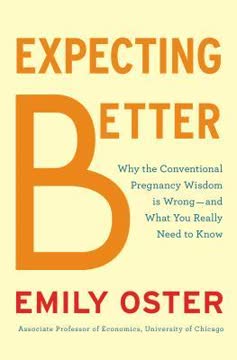

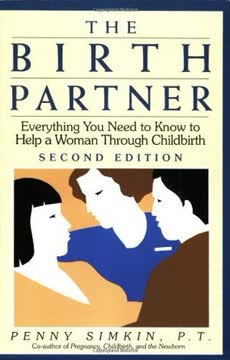

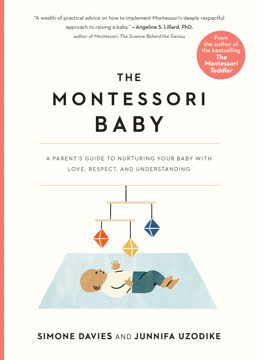
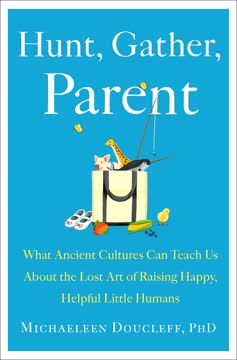
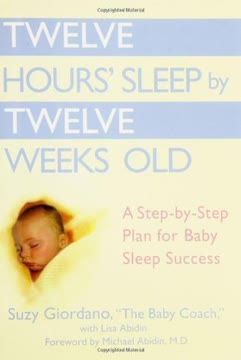
Download PDF
Download EPUB
.epub digital book format is ideal for reading ebooks on phones, tablets, and e-readers.
